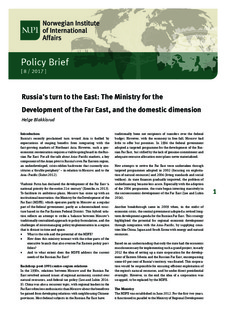| dc.contributor.author | Blakkisrud, Helge | |
| dc.date.accessioned | 2017-07-28T07:04:36Z | |
| dc.date.available | 2017-07-28T07:04:36Z | |
| dc.date.created | 2017-07-03T14:59:51Z | |
| dc.date.issued | 2017 | |
| dc.identifier.uri | http://hdl.handle.net/11250/2449476 | |
| dc.description | Russia’s recently proclaimed turn toward Asia is fuelled by expectations of reaping benefits from integrating with the fast-growing markets of Northeast Asia. However, such a geoeconomic reorientation requires a viable springboard in the Russian Far East. For all the talk about Asia–Pacific markets, a key component of the Asian pivot is Russia’s own Far Eastern region, an underdeveloped, crisis-ridden backwater that currently constitutes a ‘double periphery’ – in relation to Moscow, and to the Asia–Pacific (Kuhrt 2012). | nb_NO |
| dc.language.iso | eng | nb_NO |
| dc.publisher | Norsk utenrikspolitisk institutt | nb_NO |
| dc.relation.ispartof | NUPI Policy Brief | |
| dc.relation.ispartofseries | NUPI Policy Brief;2017-08 | |
| dc.rights | Navngivelse-Ikkekommersiell-DelPåSammeVilkår 4.0 Internasjonal | * |
| dc.rights.uri | http://creativecommons.org/licenses/by-nc-sa/4.0/deed.no | * |
| dc.title | Russia's turn to the East: The Ministry for the Development of the Far East, and the domestic dimension | nb_NO |
| dc.type | Research report | nb_NO |
| dc.description.version | publishedVersion | nb_NO |
| dc.source.pagenumber | 4 | nb_NO |
| dc.source.issue | 8 | nb_NO |
| dc.identifier.cristin | 1480528 | |
| cristin.unitcode | 7471,11,0,0 | |
| cristin.unitname | Russland, Eurasia og Arktis | |
| cristin.ispublished | true | |
| cristin.fulltext | original | |

